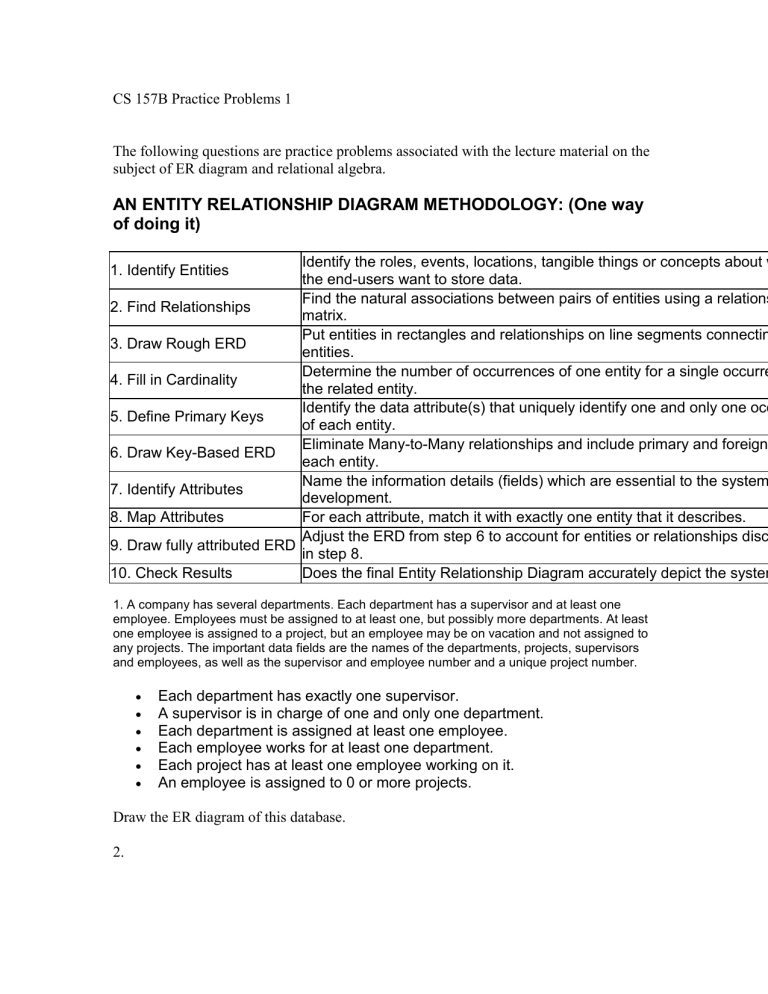28SpCS157B Practice1
advertisement

CS 157B Practice Problems 1
The following questions are practice problems associated with the lecture material on the
subject of ER diagram and relational algebra.
AN ENTITY RELATIONSHIP DIAGRAM METHODOLOGY: (One way
of doing it)
Identify the roles, events, locations, tangible things or concepts about w
the end-users want to store data.
Find the natural associations between pairs of entities using a relations
2. Find Relationships
matrix.
Put entities in rectangles and relationships on line segments connectin
3. Draw Rough ERD
entities.
Determine the number of occurrences of one entity for a single occurre
4. Fill in Cardinality
the related entity.
Identify the data attribute(s) that uniquely identify one and only one occ
5. Define Primary Keys
of each entity.
Eliminate Many-to-Many relationships and include primary and foreign
6. Draw Key-Based ERD
each entity.
Name the information details (fields) which are essential to the system
7. Identify Attributes
development.
8. Map Attributes
For each attribute, match it with exactly one entity that it describes.
Adjust the ERD from step 6 to account for entities or relationships disc
9. Draw fully attributed ERD
in step 8.
10. Check Results
Does the final Entity Relationship Diagram accurately depict the system
1. Identify Entities
1. A company has several departments. Each department has a supervisor and at least one
employee. Employees must be assigned to at least one, but possibly more departments. At least
one employee is assigned to a project, but an employee may be on vacation and not assigned to
any projects. The important data fields are the names of the departments, projects, supervisors
and employees, as well as the supervisor and employee number and a unique project number.
Each department has exactly one supervisor.
A supervisor is in charge of one and only one department.
Each department is assigned at least one employee.
Each employee works for at least one department.
Each project has at least one employee working on it.
An employee is assigned to 0 or more projects.
Draw the ER diagram of this database.
2.
3. Relation C is the join of relation A and relation B on condition p. Which of the
following statements must be true in all cases?
A.
B.
C.
D.
E.
The cardinality of C is greater than the cardinality of A
The cardinality of C is less than the cardinality of A
The arity of C is greater than the arity of A
The arity of C is less than the arity of A
None of the above
4. Relation C is a projection of relation A. Which of the following statements must be
true in all cases where relation C is different from relation A?
A.
B.
C.
D.
E.
The cardinality of C is greater than the cardinality of A
The cardinality of C is less than the cardinality of A
The arity of C is greater than the arity of A
The arity of C is less than the arity of A
None of the above
5. What type of key is a column or collection of columns that could have been chosen as
a primary key but was not?
ANSWER: (alternate)
6. What is a popular type of diagram that visually represents the structure of a database?
ANSWER: (entity-relationship (E-R) diagram)
7. For the following database:
Employee(EmpID, Ename, Salary, DeptID)
Department(DeptID, Dname, MgrEmpID, Budget)
Project(ProjID, Pname, DeptID)
Works(ProjID, EmpID, Hours)
DeptID is a foreign key in Employee and Project
ProjID and EmpID are foreign keys in Works
MgrEmpID is a foreign key in Department referencing the Employee relation
Primary keys are underlined
Department
DeptID
1
2
3
Dname
Acme
Ajax
AAA
MgrEmpID
101
104
103
100000
200000
300000
Budget
Employee
EmpID
101
102
103
104
105
Ename
Ron Blue
Jennifer Pink
Gary Green
Robert Red
Dan Black
Salary
30000
35000
40000
35000
40000
DeptID
1
2
3
2
3
Works
ProjID
40
10
30
20
20
EmpID Hours
101
20
102
40
103
30
102
20
104
10
Project
ProjID
10
20
30
40
Pname
X
Y
Z
W
DeptID
2
2
3
1
Answer the following:
(1). How many tuples will be returned by the following relational algebra query?
Salary(Employee)
(a)
(b)
(c)
(d)
2
3
4
5
(2). What is the result of the following relational algebra query?
EmpID(Employee) – EmpID(Works)
(a)
(b)
(c)
(d)
a relation with one column and one tuple whose value is 105
a relation with one column and four tuples whose values are 101, 102, 103 and 104
a relation with one column and zero tuples
none of the above
(3)What is the number of tuples returned by the query
Department X Employee X Project
(a) 12
(b) 20
(c) 60
(d) 300
(4)Which of the following relational algebra queries returns the employees (i.e., EmpID) who work
more than 10 hours on project 20?
(a)
(b)
(c)
(d)
EmpID(Hours>10 ProjID=20 (Works))
EmpID(Employee)
EmpID(Hours>10 (Works) ∩ ProjID=20 (Works))
both (a) and (c)
(5). Which relational algebra query will return employees (i.e., EmpID) who work on all projects?
(a)
(b)
(c)
(d)
EmpID(Works) U EmpID(Employee)
EmpID,ProjID(Works) ÷ ProjID(Project)
EmpID(Works) ∩ EmpID(Employee)
none of the above
(6). Which Employees (i.e., Ename) will be returned by the following query?
Ename(EmpID = MgrEmpID (Employee X Department))
(a)
(b)
(c)
(d)
Ron Blue, Jennifer Pink, Gary Green, Robert Red and Dan Black
Jennifer Pink and Dan Black
Ron Blue, Gary Green and Robert Red
Dan Black
(7). Which of the following relational algebra queries returns only the largest salary?
(a)
(b)
(c)
(d)
Salary(Employee)
Salary (Salary > Asalary(Salary(Employee) X (Asalary) (Salary(Employee))))
Salary(Employee) - (Salary(Salary < Asalary (Salary(Employee) X (Asalary) (Salary(Employee) ))))
None of the above
(8). What is the relationship between the following two relational algebra queries?
A: EmpID(Employee)
B: EmpID,DeptID(Employee)
(a)
(b)
(c)
(d)
query A will always return more tuples than query B
query A will always return less tuples than query B
query A will always return the same number of tuples as query B
query A will sometimes return less tuples than query B
(9). How many tuples will appear in the result of the following query?
Employee * Project * Department
(a) 3
(b) 4
(c) 5
(d) 7
(10). What is the result of executing the following relational tuple calculus query?
{t.Dname, s.Ename | Department (t) AND Employee(s) AND t.MgrEmpID = s.EmpID}
(a)
Acme
Ajax
AAA
Ron Blue
Robert Red
Gary Green
(b)
Ajax
Jennifer Pink
(c)
Acme
Ron Blue
(d)
Ajax
AAA
Jennifer Pink
Dan Black
17. What is the result of executing the following relational tuple calculus query
{t.Ename | Employee(t ) AND (s) ( NOT ( Employee( s)) OR t.Salary s.Salary )}
(a)
Ron Blue
Robert Red
Gary Green
(b)
Robert Red
(c)
Gary Green
Dan Black
(d)
Ron Blue
(11). Which query produces the following result?
Ename
Dan Black
DeptID
3
(a) Ename,DeptID (Salary = 40000(Employee))
(b) Ename,DeptID (Employee * Budget = 300000(Department))
(c) Ename,DeptID (Salary > 35000(Employee) * Budget < 250000(Department))
(d) none of the above
(12). Which query produces the following result?
2
3
3
1
2
1
(a)
(b)
(c)
(d)
D > C ((D)(DeptID(Department)) X (C)(DeptID(Employee)))
(DeptID(DeptID > 1(Department))) X (DeptID(DeptID < 3(Department)))
{t.DeptID, s.DeptID | Department(t) AND Employee(s) AND t.DeptID > s.DeptID}
Both (a) and (c)







